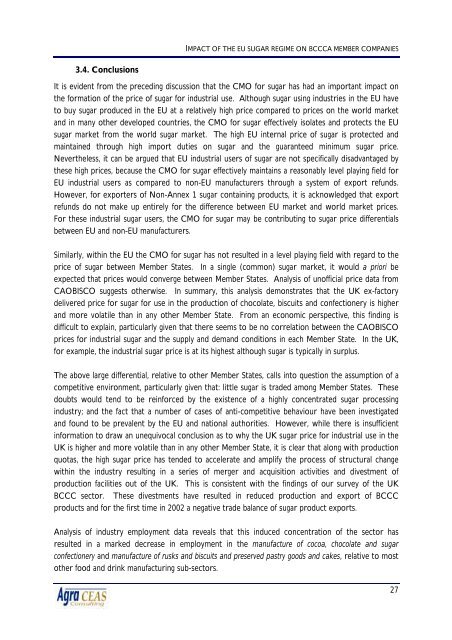2205 final report.pdf - Agra CEAS Consulting
2205 final report.pdf - Agra CEAS Consulting
2205 final report.pdf - Agra CEAS Consulting
You also want an ePaper? Increase the reach of your titles
YUMPU automatically turns print PDFs into web optimized ePapers that Google loves.
IMPACT OF THE EU SUGAR REGIME ON BCCCA MEMBER COMPANIES<br />
3.4. Conclusions<br />
It is evident from the preceding discussion that the CMO for sugar has had an important impact on<br />
the formation of the price of sugar for industrial use. Although sugar using industries in the EU have<br />
to buy sugar produced in the EU at a relatively high price compared to prices on the world market<br />
and in many other developed countries, the CMO for sugar effectively isolates and protects the EU<br />
sugar market from the world sugar market. The high EU internal price of sugar is protected and<br />
maintained through high import duties on sugar and the guaranteed minimum sugar price.<br />
Nevertheless, it can be argued that EU industrial users of sugar are not specifically disadvantaged by<br />
these high prices, because the CMO for sugar effectively maintains a reasonably level playing field for<br />
EU industrial users as compared to non-EU manufacturers through a system of export refunds.<br />
However, for exporters of Non-Annex 1 sugar containing products, it is acknowledged that export<br />
refunds do not make up entirely for the difference between EU market and world market prices.<br />
For these industrial sugar users, the CMO for sugar may be contributing to sugar price differentials<br />
between EU and non-EU manufacturers.<br />
Similarly, within the EU the CMO for sugar has not resulted in a level playing field with regard to the<br />
price of sugar between Member States. In a single (common) sugar market, it would a priori be<br />
expected that prices would converge between Member States. Analysis of unofficial price data from<br />
CAOBISCO suggests otherwise. In summary, this analysis demonstrates that the UK ex-factory<br />
delivered price for sugar for use in the production of chocolate, biscuits and confectionery is higher<br />
and more volatile than in any other Member State. From an economic perspective, this finding is<br />
difficult to explain, particularly given that there seems to be no correlation between the CAOBISCO<br />
prices for industrial sugar and the supply and demand conditions in each Member State. In the UK,<br />
for example, the industrial sugar price is at its highest although sugar is typically in surplus.<br />
The above large differential, relative to other Member States, calls into question the assumption of a<br />
competitive environment, particularly given that: little sugar is traded among Member States. These<br />
doubts would tend to be reinforced by the existence of a highly concentrated sugar processing<br />
industry; and the fact that a number of cases of anti-competitive behaviour have been investigated<br />
and found to be prevalent by the EU and national authorities. However, while there is insufficient<br />
information to draw an unequivocal conclusion as to why the UK sugar price for industrial use in the<br />
UK is higher and more volatile than in any other Member State, it is clear that along with production<br />
quotas, the high sugar price has tended to accelerate and amplify the process of structural change<br />
within the industry resulting in a series of merger and acquisition activities and divestment of<br />
production facilities out of the UK. This is consistent with the findings of our survey of the UK<br />
BCCC sector. These divestments have resulted in reduced production and export of BCCC<br />
products and for the first time in 2002 a negative trade balance of sugar product exports.<br />
Analysis of industry employment data reveals that this induced concentration of the sector has<br />
resulted in a marked decrease in employment in the manufacture of cocoa, chocolate and sugar<br />
confectionery and manufacture of rusks and biscuits and preserved pastry goods and cakes, relative to most<br />
other food and drink manufacturing sub-sectors.<br />
27













